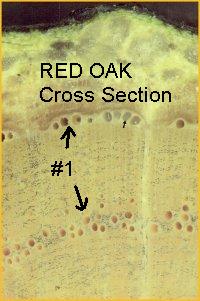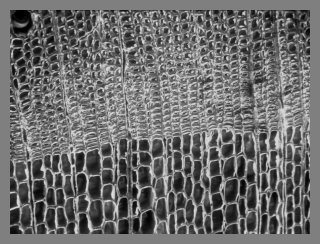
Apoplast - Apoplast
is a dead framework. It is a highly ordered connection of dead
cells and cell parts that act as a tough framework for the symplast.
The apoplast stores water, mostly as bound water, which, unlike free water,
is chemically bound to cellulose and does not flow. The apoplast is the
framework of non-living cells and cell walls in wood and bark.
The apoplast was born alive but does not function until it dies, e.g.,
vessels. Vessels are enlarged, once alive, parenchyma cells which
do not function until after death.
Apoplast, Symplast - Apoplast dead, symplast living – think
think think. Apoplast is the dead portions of the tree, the cell walls,
the vessels in time, the tracheids in time. I say in time because they are all
born alive, but in short time they all die. Just like the fibers are born
alive and the outer bark is born alive and then they die and become a part of
the apoplast.
The symplast –think living – everything is born alive. Then
as it stays alive and works many, many, bodies inside the cells keep jiggling if
you wish, moving if you wish –that’s what metabolism is all about –highly
ordered movement inside the cell in order to utilize energy that is supplied to
it.
Think symplast the living webwork. And wood is living and
dead, so what shall we call it? It is a duality of living and dead parts and
dying. The living network is primarily the inner contents of the parenchyma
cells, the thin walled cells that are still living and contain a nucleus and DNA
and other substances. So as we put dyes and materials into trees and inject
trees some of the materials move in the apoplast and some move in the symplast.
This is the reason why any physiologist never should except a paper where
someone injects a dye and then says this is the way the system goes. Because
the dye can spread in the apoplast and the symplast. Symplast – living network
and Apoplast dead network.

This sample was stained with Iodine in Potassium Iodide Solution (I2KI). A stain that turns starch grains purple. The purple you see in the wood is part of the SYMPLAST. In the wood, what is not purple, makes up the APOPLAST. What is purple is parenchyma cells with starch content. I coined the term "symplastless" as a description of wood that no longer maintains a symplast.
[1] Vessels
(SHIGO 1994)
Remember conifers do not have vessels, they have tracheids.

A close look at a conifer under an Electron Microscope.
What you see is thin walled and then thick walled tracheids.
Dictionary MAIN
PAGE
Text & Graphics Copyright © 2007
Keslick & Son Modern Arboriculture
Please report web site problems, comments and words of interest,
not found.
Contact